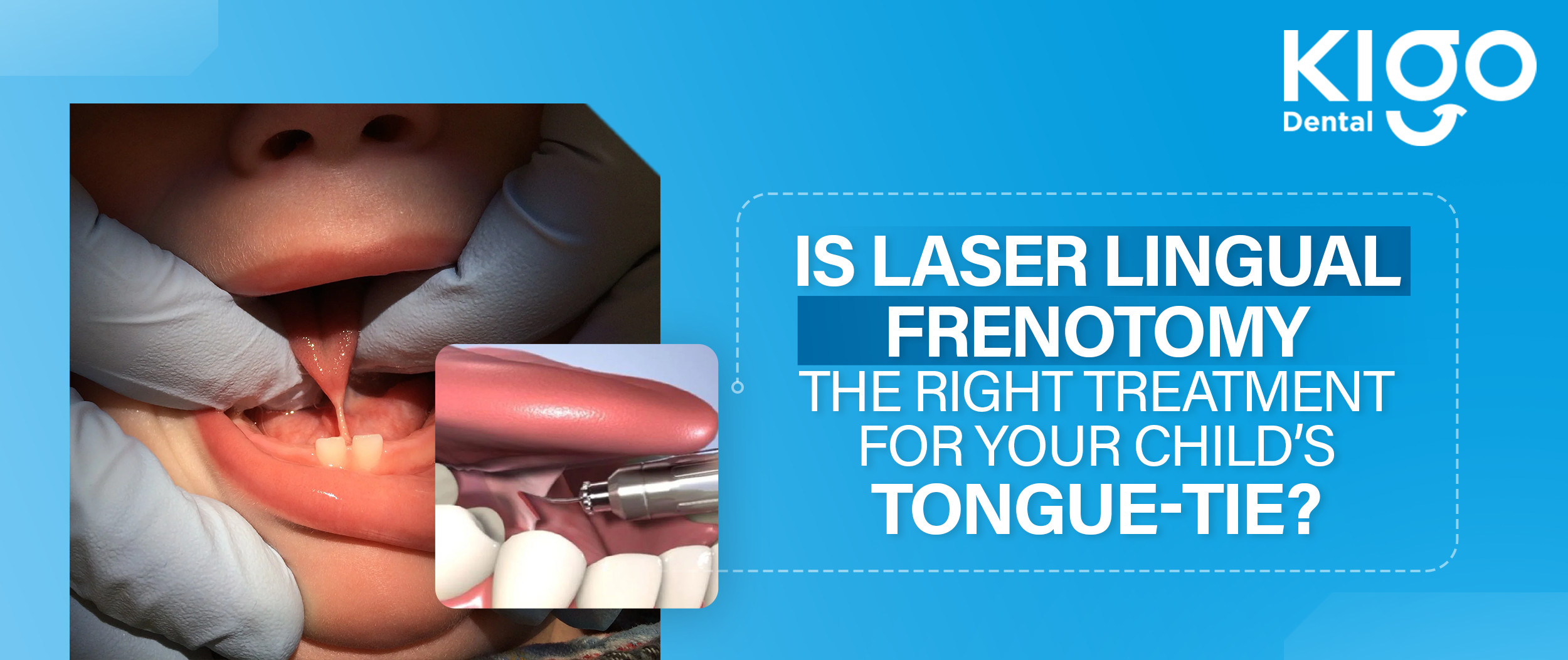As a parent, you want nothing more than to see your child thrive whether it’s their first smile, their first word, or their first bite of solid food. But what if something as simple as moving their tongue becomes a challenge? For many parents, this realization comes when their baby struggles to breastfeed, develops speech issues, or faces oral health difficulties later in childhood. These struggles often point to a condition known as tongue tie (clinically called ankyloglossia).
At Kigo Little, we meet many parents who feel anxious and even guilty when they discover their child has a tongue tie. The good news? With advancements like Laser Lingual Frenectomy treatment, correcting tongue tie has become easier, safer, and more comfortable than ever before.
In this blog, let’s explore what tongue tie is, how laser treatment works, its benefits, and whether it might be the right choice for your child.

Understanding Tongue Tie in Children
Tongue tie occurs when the thin band of tissue (lingual frenulum) connecting the tongue to the floor of the mouth is too short, tight, or thick. This restricts the tongue’s movement, leading to a variety of issues in infants and children.
Common signs of child tongue tie include:
- Difficulty latching during breastfeeding
- Poor weight gain in infants due to feeding challenges
- Clicking sounds while nursing
- Painful breastfeeding for mothers
- Delayed or unclear speech in toddlers and older children
- Difficulty sticking out the tongue or licking lips
- Challenges with oral hygiene and dental health
If left untreated, tongue tie can affect not just feeding, but also speech development, oral function, and even a child’s confidence as they grow.
What is a Laser Lingual Frenectomy?
A Laser Lingual Frenectomy is a minimally invasive dental procedure used to release the tongue tie by removing or reshaping the restrictive frenulum. Unlike traditional surgical methods that use scissors or scalpels, laser technology allows for a precise, gentle, and bloodless treatment.
At Kigo Little, our expert pediatric dentists perform this procedure using state-of-the-art dental lasers designed specifically for children. This approach ensures that your child experiences minimal discomfort, quick healing, and better long-term outcomes.
The Laser Lingual Frenectomy Treatment Process
Parents often feel anxious about what the procedure involves. Here’s a step-by-step look at how we perform a Laser Lingual Frenectomy treatment at Kigo Little:
- Initial Evaluation
Our pediatric dental specialists assess your child’s tongue mobility, feeding history, and oral development. We also listen to your concerns as a parent before suggesting treatment. - Preparation
The treatment area is cleaned, and depending on your child’s age and comfort, a mild anesthetic may be used. - Laser Procedure
Using a specialized dental laser, the restrictive frenulum is precisely released. The process usually takes only a few minutes and involves little to no bleeding. - Aftercare Guidance
Post-treatment, we guide parents through simple tongue exercises to help their child adapt to the newfound mobility. Regular follow-ups ensure the best results in feeding, speech, and oral health.
Benefits of Choosing Laser Lingual Frenectomy
Parents often ask why they should choose laser treatment over traditional surgical methods. Here are the key advantages of Laser Lingual Frenectomy treatment at Kigo Little:
- Minimally Invasive and Precise
Laser technology allows for highly accurate removal of the restrictive tissue, minimizing trauma to surrounding areas.
- Reduced Pain and Discomfort
Unlike scissors or scalpels, lasers cause less nerve stimulation, which means most children experience minimal pain.
- Little to No Bleeding
The laser seals blood vessels as it works, significantly reducing bleeding and eliminating the need for stitches.
- Faster Healing
Children recover quickly, often resuming normal feeding or speaking almost immediately after the procedure.
- Lower Risk of Infection
The sterilizing effect of the laser reduces the risk of infection post-procedure.
- Better Feeding and Speech Outcomes
Releasing tongue tie early helps infants breastfeed more effectively and supports clearer speech as children grow.
FAQs About Laser Lingual Frenectomy
- Is Laser Lingual Frenectomy safe for babies and children?
Yes. The procedure is highly safe when performed by trained pediatric dental specialists. At Kigo Little, we use advanced laser systems designed specifically for children.
- Will my child feel pain during the procedure?
Most children feel minimal discomfort. The laser’s gentle approach reduces pain compared to traditional surgical methods.
- How long does the recovery take?
Recovery is usually very quick most babies can feed immediately after the procedure, and older children adapt within a day or two.
- Will the tongue tie come back?
In most cases, once the frenulum is properly released, the issue does not return. Follow-up exercises help ensure long-term success.
- Can tongue tie affect speech if left untreated?
Yes. Severe tongue tie can restrict tongue movements, leading to speech delays or unclear pronunciation in children. Early intervention helps prevent these issues.
When Should You Consider Laser Lingual Frenectomy for Your Child?
If your child shows any of these signs, it’s worth scheduling a consultation at Kigo Little:
- Difficulty breastfeeding or bottle feeding
- Struggling with solid foods
- Delayed or unclear speech
- Frequent frustration during feeding or speaking
- Difficulty maintaining oral hygiene
Remember, early detection and treatment can make a significant difference in your child’s overall growth and development.
If you suspect your child has a tongue tie or if you’ve noticed feeding or speech difficulties, don’t wait. Schedule a consultation with the pediatric dental experts at Kigo Little today. Let us guide you through the process and provide the right care your child deserves.
Book your appointment now with Kigo Little and give your child the freedom of a confident smile and clear speech.





